Guide
The Beginner’s Guide to eCommerce Subscriptions
Start an eCommerce subscription business today
The eCommerce landscape has shifted. Subscriptions are no longer a nice-to-have business model but key to sustained growth. According to Gartner, 75% of DTC brands will offer a subscription experience by 2023.
Launching a subscription eCommerce experience, however, can feel like an insurmountable task. Not only are there multiple subscription models, but there are also other considerations like whether you should build your own experience or partner with a subscription platform.
Below, we walk through everything you need to know about subscriptions and offer a step-by-step guide to getting started.
What is a subscription business model?
The model was first introduced to the world in the 1600s by newspaper and book publishers, but with advances in technology, it’s become increasingly popular in the eCommerce space.
While you can create a subscription experience for almost any product or service, for retailers and eCommerce merchants, the business model is best suited for consumable products.
For instance, coffee, beauty supplies, and pet food are perfect products for subscriptions because consumers must replace them on an ongoing basis.
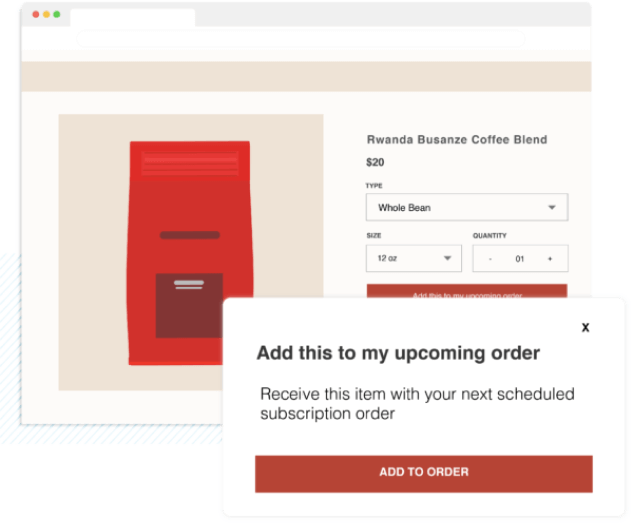
On the other hand, pots and pans aren’t a great fit for subscriptions because consumers don’t need to buy cookware on a recurring basis. In other words, pots and pans are less consumable than coffee and beauty supplies.
It’s also important to note that subscriptions can be a merchant’s primary business model or one part of a larger business strategy.
Some merchants make a subscription experience their primary business strategy. We refer to these merchants as subscription-first businesses.
Other merchants — commonly large brands — incorporate subscriptions into their overall business strategy. In this instance, subscriptions might make up only a portion of the brand’s revenue. We refer to these types of companies as subscription-second businesses.
Types of eCommerce subscription businesses
There are three primary types of subscription business: Subscribe and Save; Curation; and Membership. Each model can help you achieve your business goals, but they have unique benefits and challenges.
Subscribe and save
A Subscribe and Save experience — also known as a replenishment or auto-ship service — provides regular, recurring delivery of a product to consumers. Subscribe and Save is also the most popular business model among consumers. If you already have a transactional business and want to jump into subscriptions, this is the best option.
If you already have a transactional business and want to jump into subscriptions, Subscribe and Save is the best option.
Benefits
- High conversion rate. Subscribe and Save has the highest conversion rate among the three subscription business models, according to McKinsey. Sixty-five percent of consumers who consider a replenishment service subscribe.
- High retention rate. Replenishment services also have a high long-term subscription rate: 45% of subscribers keep their subscription for at least one year.
- Less operational complexity: Subscribe and Save is easier to launch than other subscription models. With Subscribe and Save, you’re selling products you already have, meaning orders should be easier to fulfill. You’ll never have to hunt down new products, the same way you will need to with a curated subscription experience.
Challenge
Increased competition. Merchants of all sizes and across verticals are launching Subscribe and Save experiences, thanks primarily to the benefits highlighted above. To thrive in this space, you’ll need a top-notch acquisition and retention strategy. More on this later.
Subscribe and save examples:
THE HONEST COMPANY
The Honest Company entices customers to enroll in their subscription program on their Product Display Page and Shopping Cart.
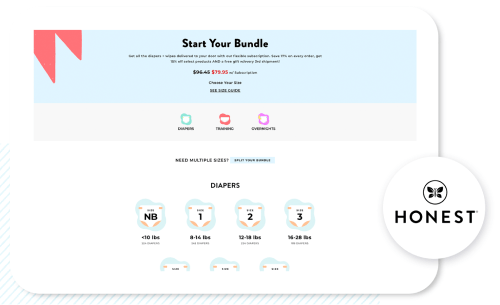
PEET’S COFFEE
Coffees and teas are an excellent fit for Subscribe and Save. They’re consumable items that are part of many shoppers’ morning rituals. Peet’s subscription experience delivers coffee to shoppers every month.
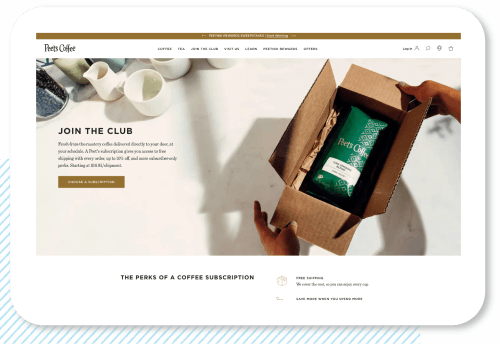
TATA HARPER
Clean beauty brand Tata Harper lets shoppers sign up for a recurring order that matches their needs. For example, consumers can select a delivery frequency between 1 to 6 months.
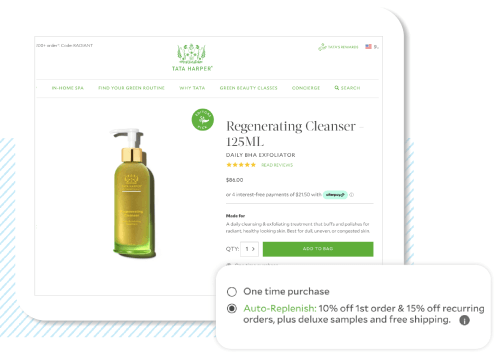
Curation
Increased competition. Merchants of all sizes and across verticals are launching Subscribe and Save experiences, thanks primarily to the benefits highlighted above. To thrive in this space, you’ll need a top-notch acquisition and retention strategy. More on this later.
Benefits
Highly profitable. When done right, curation can be extremely lucrative. On average, this business model has a higher average order value than other subscription experiences.
Challenges
- High churn rate. Curation relies on curiosity. Once a subscriber’s curiosity is met and they understand the type of products they’ll receive on a recurring basis, they’re more likely to churn. Merchants with successful curation experiences dedicate significant resources to personalizing their boxes to keep their subscribers engaged.
- Operational complexity. Curation requires that you source multiple different products for each box on an ongoing basis. Curation also requires that you consider your subscribers’ unboxing experience and spend resources on branding and packaging. As a result, Curation requires more resources to manage than Subscribe and Save.
- High level of competition. Curation is the most common subscription business model. Before launching your program, you’ll need to research your niche.
Curation examples:
BLUE APRON
One of the most well-known examples of Curation is Blue Apron. The meal-kit company sends subscribers all the ingredients they need to make a fast and delicious meal.
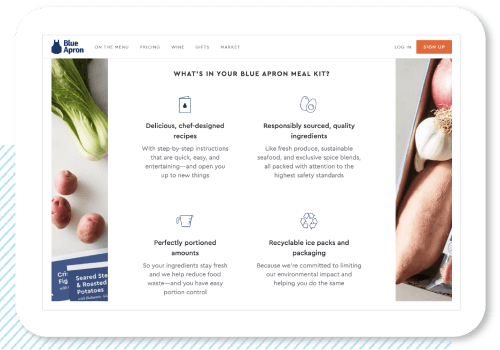
STITCH FIX
Stitch Fix is a personal styling service. Customers fill out a questionnaire about their style and then they receive a personalized box of clothing regularly.
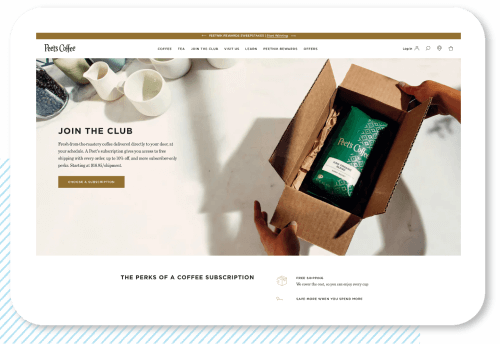
CLAIRE’S
Claire’s curation experience is called Cdrop. Once a quarter subscribers receive a curated assortment of trendy jewelry and accessories. Claire’s offers three themed “drops” that target different audiences — earring lovers; older teens and younger adults; and children.
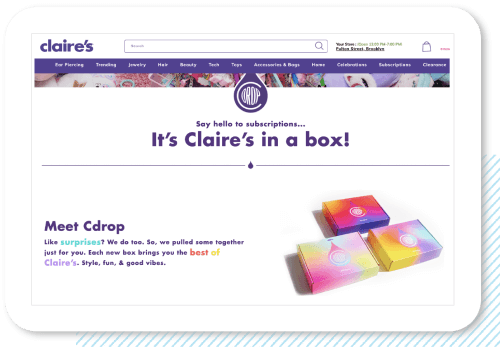
Membership
A Membership subscription experience gives consumers access to the value an organization creates in exchange for a recurring fee.
Benefits
Flexibility. Because you aren’t selling a specific product, you can personalize your membership offering based on your customers’ needs. This will drive loyalty and increase customer lifetime value.
Challenges
- Time-consuming. You’ll need to continually evaluate whether the services and access you offer meet your customers’ needs and adapt.
Membership examples:
Perhaps the best-known example of a membership subscription is Costco. A membership with the retailer comes with steep discounts on products.
Golf courses are another example of a traditional membership subscription. Members gain access to desirable experiences like the ability to play a round of golf.
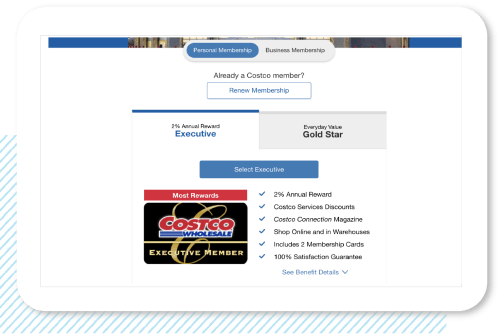
Membership subscriptions, however, aren’t tied to a physical location. Wellness brand GNC runs myGNC PRO Access. For a low membership fee, subscribers receive deep discounts, expedited shipping, pre-sale access to products, and swag boxes that are delivered twice a year.
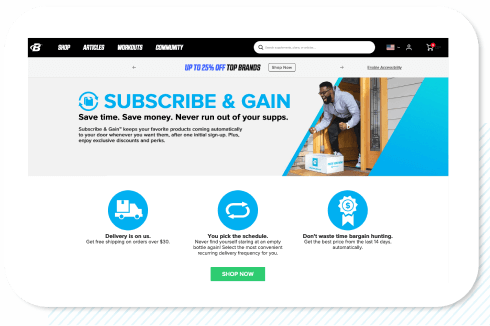
Why launch an eCommerce subscription business?
Now that you know about subscriptions, let’s unpack their many benefits.
1. Reliable, recurring revenue
Subscriptions’ biggest benefit is that they create a reliable, recurring revenue stream.
2. Increase customer lifetime value (CLV)
Competition and acquisition cost in the eCommerce space is high. Subscriptions offset rising costs by extending CLV and improving ROI.
3. Improve inventory forecasting
With subscriptions, you know how many customers are going to buy which products in a given period. This helps better evaluate your inventory and limits the risk of overstocking.
4. Generate more customer insights
Subscriptions enable you to generate data about your customers and quickly act to meet their needs. This creates a virtuous cycle in which you can gather information, incrementally improve your buying experience, and then delight your customers.
5. More interest from investors
Investors love subscriptions. A predictable revenue model enables you to aggressively invest in growth. In fact, companies with recurring revenue models are valued 8X greater than companies with transaction-based business models.
Companies with recurring revenue models are valued 8X greater than companies with transaction-based business models.
Subscription-first businesses can also disrupt established industries by offering lower upfront costs because they expect to keep the customer for longer.
Build vs buy: Which is best for you?
If you decide to launch a subscription experience, you’ll need to either build your own subscription solution or partner with a subscription technology provider. Here are two key questions to consider when making the decision:
1. What are your resources?
Building your own subscription experience requires significant resources. Not only will you need developers and eCommerce experts for the initial implementation, but you’ll also need a team to manage your subscription experience once it’s up and running.
With a homegrown subscription experience, you’ll need to determine subscription eligibility and inventory, create a workflow to manage subscription-related inquiries, and build an analytics tool to gauge the success of your experience.
You’ll also need to build an interface where subscribers can manage their subscriptions. Otherwise, you may risk subscriptions causing frustration rather than loyalty.
When deciding what’s right for your company, remember that there is also an opportunity cost associated with building your own subscription solution. Every hour your team spends on this initiative is one that can’t be spent on other projects.
If you do have abundant resources, a homegrown subscription solution comes with at least one advantage: a custom-built subscription experience is extremely flexible. Because you own the software, you can change it to meet your business needs.
2. How quickly do you want to launch?
Your answer is probably yesterday. Every day you don’t have subscriptions is another day of missed opportunity to convert one-time purchases into recurring revenue.
If you need to get up and running fast, opt for a subscription technology provider. A homegrown solution could take a year or more to develop and implement. And when your subscription experience does finally launch, it’s unlikely that your company will have the skillset to ensure it’s a hit from the get-go.
Plus, if you choose to build your own subscription solution, you’ll need to ensure it integrates with important eCommerce tech like your eCommerce platform, payment providers, and inventory management solutions, among others. Remember, every integration your team needs to build delays your launch.
If you need to get up and running fast, opt for a subscription technology provider.
Popular eCommerce subscription technologies
There are dozens of subscription technologies on the market. The two most common are recurring billing solutions and subscription platforms.
1. Recurring billing solution
A recurring billing solution is a system that eliminates manual billing, which is often complex and time-consuming. In other words, with a recurring billing solution, you can easily invoice your subscribers on a regular basis.
Recurring billing solutions sometimes offer basic portals for customers to manage their subscriptions. They might also allow merchants to do simple promotions on subscription items, though this is not the norm.
If you sell a digital product, a recurring billing solution is a good option. However, recurring billing solutions are a poor fit for consumable goods.
2. Subscription platform
Unlike a recurring billing solution, a subscription platform helps you manage all aspects of your subscription experience, including acquisition and checkout, billing, subscriber management, and retention efforts. Subscription platforms are best for businesses that sell consumable goods and want to rapidly scale.
If there is a chance you might outgrow your exciting eCommerce platform, then be sure to look for a subscription platform that integrates with a variety of popular eCommerce platforms, like Shopify, Magento, Big Commerce, and Salesforce.
Why your subscription platform needs an integrated checkout
When evaluating a subscription platform, make sure that it fully integrates with your eCommerce platform and that it uses an integrated checkout.
Subscription platforms that don’t fully integrate with your eCommerce platform create operational pains and poor customer experiences.
For example, subscription solutions that don’t fully integrate with an eCommerce platform send shoppers to a separate checkout to complete their purchase. This is known as a hijacked checkout.
In addition to creating a poor buying experience and a potential loss of conversion, a hijacked checkout forces merchants to keep duplicate product catalogs and even discount codes, which is a huge time suck and diverts resources from larger, more important strategic initiatives.
A hijacked checkout also creates a data nightmare, as you lose tracking information when the shopper is sent off your site.

Data shows that a hijacked checkout can decrease subscription enrollment by as much as 40%.
Learn more:
Customer loyalty: A complete guideMust-have eCommerce subscription technology capabilities
A successful subscription experience requires robust acquisition and retention capabilities. Whether you chose to build your own subscription solution or partner with a subscription platform, make sure your experience has these features:
Promotional capabilities
One of the primary reasons consumers sign up for a subscription experience is to receive an additional benefit like a gift or discount. Here are some promotional capabilities you’ll need:
- Discounts: We’ve found that a 5% discount increases subscription enrollment by 104%.
- Free shipping: This is one of the most popular incentives in eCommerce. 85% of shoppers say that not having free shipping for online orders is a “deal-breaker.”
- Subscribe more, save more benefits: This incentive encourages customers to sign up for more subscriptions by offering greater incentives. For example, a beauty brand might offer 10% for one subscription, 15% off for two, and 20% for three or more.
- Cross-selling: This capability drives up average order value by letting subscribers add one-time purchases to their recurring orders.
Retention capabilities
Churn is subscriptions’ biggest challenge. You’ll need a subscription experience with churn-busting capabilities like these:
- Intuitive subscription management portal: Consumers love flexibility. Give them a subscription management portal that lets them skip, pause, or change their order frequency. Your portal should also allow subscribers to easily cancel. Cancelation blockers erode trust in your brand — don’t use them.
- Retention rewards: This incentive encourages subscribers to stay with their subscription longer. Typically, shoppers receive an incentive after a set number of orders.
- Operational tools: You’ll want to be able to swap out-of-stock items and proactively refresh credit card information.
Step-by-step guide: How to start an eCommerce subscription business
A successful subscription experience requires robust acquisition and retention capabilities. Use this step-by-step guide to launch a successful subscription experience.
Determine your market fit
Most companies that sell consumable products can launch a subscription experience. However, some products and industries are better suited for subscriptions than others. Ask yourself these questions to determine your market fit:
Does your product or service warrant a subscription experience?
Products that need to be replenished regularly, such as shaving supplies, are a strong fit for a subscription experience. On the other hand, products and services that are needed irregularly aren’t a great fit. For instance, a subscription for power tools is less likely to succeed.
If you sell multiple products, start by looking at your product SKUs to see which have repeat purchases. You might be surprised.
Who are your competitors and what are they offering?
Your goal here is to determine what type of subscription experiences are in the market and the value they offer their subscribers. It’s unlikely that you’ll be the first subscription experience in your industry, and that’s fine. You can compete — and win — by offering subscribers better value.
In general, consumers sign up for subscriptions to save money, for convenience, and for a personalized experience. You’ll need to determine how and if your competitors are providing their subscribers with these values.
What is your unique selling proposition?

Once you’ve researched your competitors, you should have a good understanding of their strengths and weaknesses. This will help you determine how your subscription experience will stand out.
For example, if your competitor’s subscription experience is expensive, you can offer consumers a similar experience at a lower price. On the other hand, if your competitor’s subscription experience offers their customers great discounts, you can offer a more personalized experience.
Set your business goals
What exactly do you want to accomplish with your subscription experience?
For transactional businesses, subscriptions provide an opportunity to build direct-to-consumer (D2C) recurring relationships, reducing the risk of your most loyal customers jumping to other brands.
If you run a D2C business, you’ll have a different goal. For a growing percentage of D2C merchants, subscriptions are their predominant offering and account for the majority of their business. Your goal should be to retain subscribers and build word of mouth.
Determine your subscription program’s incentives
A subscription program’s success relies on creating a strong value proposition that rewards both initial and recurring orders. To this end, you’ll need to develop a strong promotion/incentive strategy.
Subscription needs to be the most rewarding way to shop your site, while also aligning with your overall promotions strategy.
For example, if you frequently offer 15% off discounts, don’t select a 0-5% off subscription incentive.
If you don’t want to offer frequent percentage-off discounts, find another meaningful incentive such as every third order free or a gift with purchase.
Here are some real-life value propositions from our customers:
IT Cosmetics offers 10% off all orders, 15% off every 3rd order, and free shipping on all recurring orders
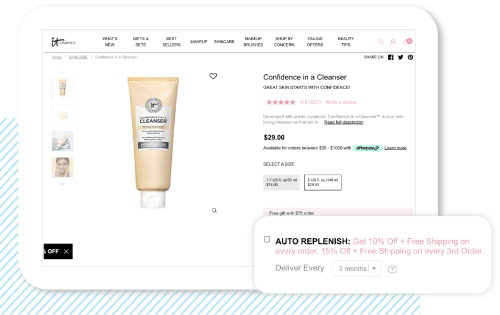
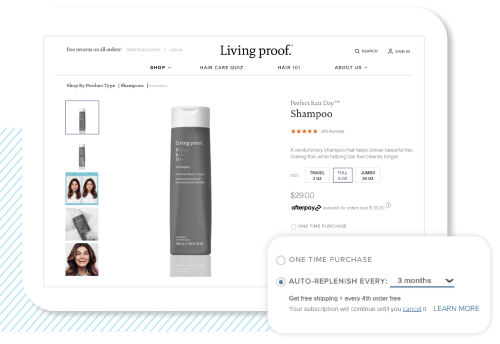
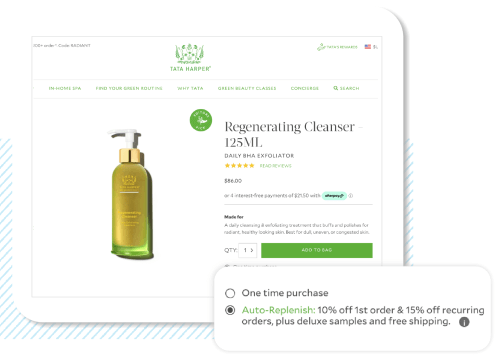
Develop an enrollment strategy
Once you know your subscription program’s incentives, it’s time to use them to acquire subscribers. We recommend you use these tactics:
Promote your subscription program across your entire site
Offer multiple enrollment locations
This tactic enables shoppers to enroll in your subscription experience at multiple points in their buying journey. It’s common for merchants to offer subscription enrollment on their Product Display Page, Shopping Cart, and through a Quick View.
Implement a guided selling experience
A guided selling experience makes shopping hassle-free. It reduces the amount of time a potential customer spends researching your product and ensures their expectations are met. For instance, Darwin’s Natural Pet Products uses a guided selling experience to ensure the products they recommend fit shoppers’ needs.
Think about the subscription experience holistically and ensure it’s visible within the typical customer journey on your site and leverages all of your on-site experiences. Not all value is monetary — access to content and exclusive experience (early product releases) are powerful enrollment drivers.
Develop a retention strategy
Enrollment is important as you’ll need to grow your subscriber base, but retention is critical to driving subscription performance and reliable, recurring revenue. Once your program is off the ground you should focus your efforts on building customer loyalty.
Strategies to adopt:
SKIP ORDER: Subscribers last 135% longer when they can skip an order.
Some merchants are scared to make it easy for subscribers to pause, skip, or cancel a subscription. This is a huge mistake. Merchants that make it easy for their subscribers to manage their recurring orders see a higher retention rate and happier, more loyal customers.

SKIP ORDER
Subscribers last 135% longer when they can skip an order.

PRODUCT SWAP
Subscribers last 71% longer when they can swap a product.
Offer retention rewards
Retention rewards are a way to reward subscribers for remaining in the program and receiving recurring orders. Typically, shoppers receive an incentive after a predetermined number of orders. The incentive could be a free order, a gift with purchase, or an increased discount.
You should also consider integrating your subscription experience with a loyalty program.
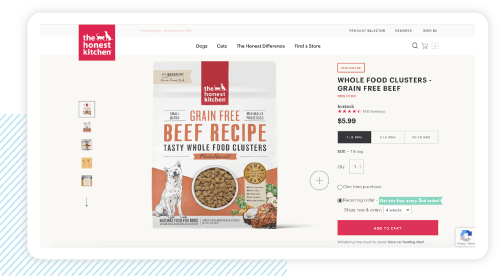
Leverage future order data to proactively engage customers and re-educate them on the value of your subscription program and the flexibility they have to manage their subscriptions.
Learn more:
Customer loyalty: A complete guideDetermine your Marketing strategy
At this point in the process, you should have your subscription experience up and running. Now, it’s time to tell the world about it.
Use these promotional strategies to drive interest in your subscription experience:
- Send an email blast to your current customers
- Partner with influencers in your space to promote your program
- Develop content like blog posts and videos that highlight subscription
- If you have a physical location, add subscription information signage
Remember, this is on top of having a dedicated subscription landing page and information about your program on your homepage.
Pick a compelling name for your subscription and leverage your existing campaigns. Subscriptions should be a mainstay of your messaging, not an add-on or occasional topic.
Some of our favorite subscription names:
Yankee Candle’s Fragrance Flight
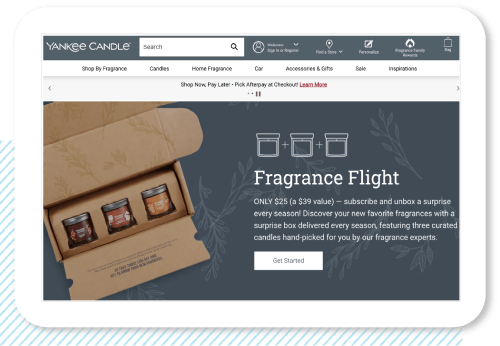
Bodybuilding.com’s Subscribe and Gain
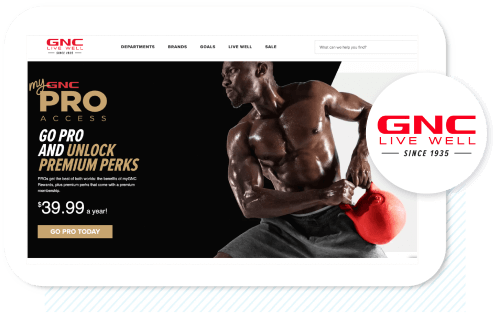
4ocean’s Clean Ocean Club
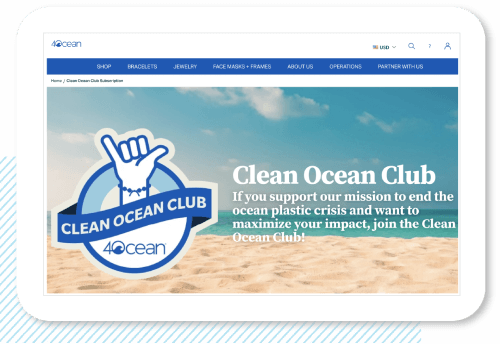
Monitor your program
There are countless ways to monitor the success of your subscription experience. We recommend that you track these metrics:
- Revenue and margin: Gross merchandise value; average order value; and average subscription value.
- Program size: Active subscription and subscriber base size; net gains/enrollments; subscription and subscriber monthly adds.
- Conversion: Buyer to subscriber ratio; top products.
- Retention: Churn; lifetime value, recurring order count.
Learn more:
Customer loyalty: A complete guideConclusion
Subscription experiences are going to continue to dominate the eCommerce space. If subscriptions are right for your brand, take the time to determine which subscription business model is right for your business needs and whether you should build your own experience or partner with a subscription platform. This will ensure you hit the ground running and that your program is a success from day one.

